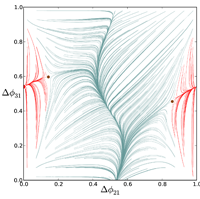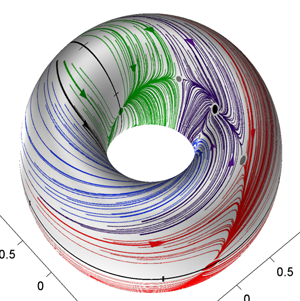A central pattern generator (CPG) is a neural microcircuit of cells that are capable of producing rhythmic patterns that underlie motor behaviors such as heartbeat, respiration, and locomotion in animals and humans. These patterns do not require sensory input or external patterned inputs, but rather are an emergent property of the network. Burst firing activity is usually associated with CPG activity. In some cases intrinsically or conditionally bursting pacemaker neurons are thought to be responsible for the rhythm, whereas in other cases the basic pattern generating unit is though to be a half center oscillator in which synaptic escape or release of each oscillator in turn drives the network rhythm. Here we focus both on the mechanisms for robustness in dedicated CPGs and for flexibility in multifunctional CPGs that can produce distinct rhythms, such as swimming versus crawling, and alternation of blood circulation patterns in leeches. Robustness to heterogeneity and noise of individual modes allows for phase constancy under a wide variety of conditions. Flexibility may be attributed to switching between rhythms by input-dependent switching between attractors of the CPG. We will focus on experimental approaches, often using the dynamic clamp, combined with various mathematical and computational techniques for understanding the underlying principles sub-serving pattern generation.
CNS 2012 Workshop: July 26, 2012
Principles of Motor Pattern Generation:
Experiments and Modeling
Workshops will take place on July 25 and 26 at the Agnes Scott College For Women located in Decatur
Contacts: ccanav@lsuhsc.edu - ashilnikov@gsu.edu
July 26, 2012
Tentative schedule
9:00 ‐ 9:40 Allen Selverston (UCSD) "New ways for experimentalists and modelers to look at CPGs"
9:40: ‐ 10:20 Akira Sokurai (GSU) "A natural example of different circuit architectures for analogous
behaviors in different species"
Coffee break ‐ 15min
10:30 ‐ 11:10 Andrey Shilnikov (GSU) "Bifurcation of polyrhythmic patterns in 3‐cell bursting motifs"
11:10 ‐ 11:50 Thomas Nowotny (Sussex, UK) "Central patterns generation with heteroclinic orbits"
Lunch break
13:00 ‐ 13:40 Brian Mulloney (UC Davis) “Experimental and computational analysis of an
intersegmental coordination circuit”
13:40 ‐ 14:20 Carmen Canavier (LSU) "Functional phase resetting and the pyloric circuit"
Coffee break – 20 min
14:40 ‐ 15:20 Maxim Bazhenov (UCR) "Ionic dynamics mediate tonic‐clonic pattern generation in
epilepsy"
15:30 ‐ 17:30 Panel discussion – “CPG modeling and verification feedback”
18:30 Dinner at “The Iberian Pig”
121 Sycamore Street
Decatur, GA 30030 (404) 371‐8800
http://www.iberianpigatl.com/index.php
http://www.theiberianpigatl.com/pdf/Menu.pdf
SPEAKERS
Allen Selverston (UCSD) "New ways for experimentalists and modelers to look at CPGs"
Akira Sokurai (GSU) "A natural example of different circuit architectures for analogous behaviors in different species"
Thomas Nowotny (Sussex, UK) "Central patterns generation with heteroclinic orbits"
Maxim Bazhenov (UCR) "Ionic dynamics mediate tonic-clonic pattern generation in epilepsy"
Brian Mulloney (UC Davis) “Experimental and computational analysis of an intersegmental coordination circuit”
Carmen Canavier (LSU) "Functional phase resetting and the pyloric circuit"
Andrey Shilnikov (GSU) "Bifurcation of polyrhythmic patterns in 3-cell bursting motifs"
If you would like to give at talk at the workshop, please contact us: ccanav@lsuhsc.edu - ashilnikov@gsu.edu


